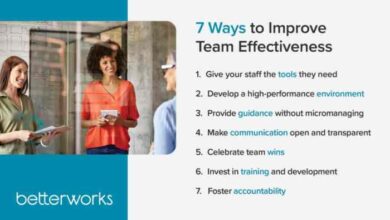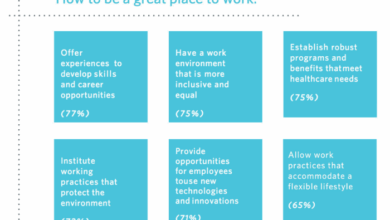
Trust at work core to high performance – Trust at work, core to high performance, is more than just a feeling; it’s a fundamental driver of success. A strong foundation of trust within a team fosters a positive and productive work environment. This exploration delves into the multifaceted nature of trust in the workplace, examining its impact on employee engagement, collaboration, and overall organizational performance. We’ll uncover the essential elements of building trust, from effective leadership to a supportive organizational culture.
Understanding the different dimensions of trust, such as interpersonal and organizational trust, is crucial. This exploration examines how various factors like communication, transparency, and conflict resolution directly influence the level of trust within an organization. We’ll look at specific examples of how trust can be cultivated and how it impacts various performance metrics.
Defining Trust at Work

Trust is the bedrock of high-performing teams and organizations. It’s the belief that others will act in good faith and with integrity, even when not directly supervised. Without trust, collaboration suffers, productivity stagnates, and innovation is stifled. Cultivating a culture of trust is a crucial leadership responsibility, impacting everything from employee engagement to overall organizational success.Workplace trust isn’t a single entity; it’s a multifaceted concept built on a foundation of reliability, consistency, and transparency.
It encompasses interpersonal relationships, organizational practices, and a shared commitment to ethical conduct. Understanding the various dimensions of trust is key to fostering a healthy and productive work environment.
Defining Trust in a Professional Setting
Trust in a professional setting is the confidence that another person or entity will act in a reliable, honest, and ethical manner. This confidence is developed through consistent, positive interactions and a demonstrated commitment to shared values and goals. It’s not simply believing someone; it’s a rational assessment based on observed patterns of behavior.
Key Components of Workplace Trust
Several key elements contribute to trust within a workplace. These include:
- Competence: Employees must believe their colleagues and leaders possess the skills and knowledge to perform their jobs effectively. Demonstrating competence through successful project completion and consistent delivery builds trust.
- Integrity: Honesty, ethical conduct, and adherence to organizational values are critical components of trust. Transparency in decision-making and communication, along with a willingness to admit mistakes, strengthens integrity.
- Consistency: Reliable behavior and predictable actions are essential for building trust. Employees need to feel confident that promises made will be kept, and that actions align with stated intentions.
- Open Communication: Transparent and honest communication fosters understanding and reduces suspicion. Active listening and clear articulation of expectations contribute significantly to building trust.
- Respect: Treating colleagues with respect, regardless of differences in opinion or background, is fundamental to building a trustworthy environment. Valuing diverse perspectives and recognizing individual contributions are crucial.
Trust vs. Confidence
While trust and confidence are related, they differ in their nature. Confidence is a belief in one’s own abilities or in a specific outcome. Trust, however, is a belief in another person’s reliability and integrity. In the workplace, trust is essential for collaboration and teamwork, while confidence is essential for individual performance.
Behaviors That Build Trust
Numerous behaviors contribute to the development of trust. These include:
- Keeping promises: Following through on commitments, both large and small, is paramount to building trust.
- Being accountable: Taking responsibility for mistakes and errors demonstrates integrity and a commitment to continuous improvement.
- Actively listening: Paying attention to what others say and valuing their perspectives fosters a sense of respect and shared understanding.
- Being transparent: Sharing information openly and honestly promotes trust and reduces suspicion.
- Supporting colleagues: Collaborating, helping, and assisting team members fosters a sense of community and shared purpose.
Types of Trust
Different types of trust exist in the workplace, including:
- Interpersonal Trust: This refers to the trust individuals have in one another, built on personal interactions and shared experiences.
- Organizational Trust: This encompasses the trust employees have in the organization’s leadership, policies, and overall practices.
Dimensions of Trust
| Dimension | Description | Examples |
|---|---|---|
| Competence | Ability to perform tasks effectively and efficiently. | Meeting deadlines, completing projects successfully, possessing relevant skills. |
| Integrity | Adherence to ethical principles and honesty. | Honesty in communication, fulfilling promises, acting with integrity in challenging situations. |
| Benevolence | Willingness to act in the best interests of others. | Helping colleagues, supporting team members, going the extra mile for the team. |
| Justice | Fairness and equity in decision-making and interactions. | Following established procedures, treating everyone fairly, avoiding bias. |
The Impact of Trust on High Performance
Trust is the bedrock of any high-performing team. It’s not just a nice-to-have; it’s a critical element driving positive outcomes, from increased productivity to reduced conflict. A trusting environment fosters a sense of psychological safety, empowering employees to take risks, collaborate effectively, and ultimately achieve extraordinary results.A strong foundation of trust significantly impacts employee engagement and motivation. When employees trust their leaders and colleagues, they feel valued, respected, and empowered to contribute their best work.
This sense of belonging and trust directly translates into increased engagement, driving intrinsic motivation and a higher level of commitment to the organization’s goals. Employees are more likely to go the extra mile when they feel their contributions are valued and their voices heard.
Trust and Employee Engagement
Trust is a key driver of employee engagement. Employees who trust their leaders and colleagues are more likely to be engaged in their work and committed to the organization’s goals. This engagement leads to a higher level of job satisfaction, increased productivity, and reduced employee turnover.
Trust and Motivation
Trust fosters a positive work environment that motivates employees to perform at their best. When employees feel trusted, they are more likely to take initiative, collaborate effectively, and strive to achieve ambitious goals. This trust-driven motivation results in increased productivity and a stronger sense of commitment to the team and the organization.
Trust and Collaboration
Trust is essential for effective collaboration and teamwork. When employees trust each other, they are more willing to share ideas, support each other, and work together towards common objectives. This fosters a collaborative spirit, leading to innovative solutions and enhanced problem-solving capabilities. In essence, trust empowers teams to function as highly effective and cohesive units.
Trust and Productivity
Trust directly correlates with productivity. When employees trust their leaders and colleagues, they feel comfortable taking risks, experimenting with new ideas, and challenging the status quo. This risk-taking environment, fostered by trust, leads to innovative solutions, improved efficiency, and ultimately, increased productivity.
Trust is fundamental to high performance in any workplace. Modern teams need to rely on each other, and that trust often hinges on efficient tools. The new wave of app development is changing how we work, and innovative platforms like the new wave of app development are streamlining workflows and fostering better communication. Ultimately, these advancements empower teams to collaborate more effectively, which directly reinforces the importance of trust as a core component of high-performing work environments.
Trust and Reduced Conflict
Trust significantly reduces conflict in the workplace. When employees trust each other, they are more likely to communicate openly and honestly, resolving disagreements constructively and efficiently. This leads to a more positive and harmonious work environment, minimizing unproductive conflicts and maximizing the team’s overall performance.
Stages of Trust Development and Performance Impact
| Stage | Description | Impact on Performance |
|---|---|---|
| Initial Trust | Employees cautiously assess their colleagues and leaders. They observe interactions and gather information about behavior and intentions. | Performance is generally reactive and focused on individual tasks. Collaboration may be limited. |
| Developing Trust | Employees begin to see consistency in behavior and intentions. Positive interactions and shared experiences increase. | Performance improves as individuals feel more comfortable taking risks and working together. Collaboration becomes more effective. |
| Strong Trust | Employees exhibit high levels of confidence in their colleagues and leaders. Open communication and shared goals are evident. | Performance is highly efficient and innovative. Teams achieve exceptional results due to high levels of collaboration and shared purpose. |
Building Trust in the Workplace
Cultivating trust within a company is not a passive endeavor; it’s an active process requiring consistent effort and a genuine commitment to employee well-being. A trustworthy environment fosters collaboration, encourages innovation, and ultimately leads to higher performance across all levels. It’s a foundational element in building a successful and thriving organization.Establishing trust is paramount to a positive work atmosphere.
A foundation of trust allows for open communication, reduces conflict, and increases overall job satisfaction. Employees feel valued and respected when they know their concerns are heard and addressed. This leads to a more productive and efficient workplace.
Open Communication and Transparency
Open communication channels are crucial for building trust. Regular and honest communication fosters a sense of shared understanding and reduces speculation. Transparent practices, including clear communication of company goals and decision-making processes, demonstrate a commitment to fairness and accountability. This transparency also allows employees to understand how their work contributes to the larger picture. Leaders who actively communicate, both formally and informally, build trust and strengthen relationships.
Fostering a Culture of Respect and Fairness
A culture of respect and fairness is fundamental to building trust. This encompasses treating all employees with dignity and consideration, regardless of their position or background. Implementing fair policies and procedures, such as equitable compensation and promotion practices, reinforces the perception of a just and equitable workplace. Actively promoting diversity and inclusion further enhances the perception of fairness and respect, creating an environment where everyone feels valued.
Actively Listening to Employee Concerns
Creating a system for actively listening to employee concerns is essential for building trust. Establishing clear channels for feedback, such as suggestion boxes, surveys, or regular one-on-one meetings, allows employees to voice their concerns and suggestions without fear of retribution. It’s important to acknowledge and address these concerns promptly and empathetically. Demonstrating that employee input is valued significantly contributes to the development of a strong and trusting work environment.
Resolving Conflicts Constructively
Constructive conflict resolution is vital for maintaining a trusting atmosphere. Establishing clear protocols for handling disagreements and disputes is important. Mediation, arbitration, or other conflict resolution techniques can facilitate a more productive outcome. Focusing on finding mutually acceptable solutions and understanding different perspectives fosters a sense of collaboration and mutual respect. Open and honest communication during conflict resolution is key to fostering trust.
Strategies for Building Trust in Various Situations
| Situation | Action | Rationale |
|---|---|---|
| New employee onboarding | Clearly defined expectations, regular check-ins, opportunities for questions and feedback. | Reduces uncertainty and sets clear expectations for new employees. |
| Performance issues | Open discussion, constructive criticism, and support for improvement. | Addresses concerns directly, focusing on solutions rather than blame. |
| Difficult team dynamics | Facilitated team-building activities, clear communication of roles and responsibilities, and conflict resolution strategies. | Encourages understanding, cooperation, and respect amongst team members. |
| Change management | Transparent communication about the reasons for change, opportunities for input, and support during the transition. | Maintains trust during periods of uncertainty by keeping employees informed and involved. |
| Company-wide crises | Honest communication, reassurance of support, and clear plans for action. | Shows commitment and concern during challenging times, reinforcing trust in leadership. |
Trust and Leadership
Trust is the bedrock upon which high-performing teams are built. Leaders play a pivotal role in establishing and maintaining this trust, as their actions and behaviors directly influence the psychological safety and productivity of their teams. A leader’s commitment to ethical conduct, transparent communication, and empowering employees significantly contributes to a trustworthy work environment.Effective leadership fosters an environment where employees feel valued, respected, and confident in their ability to contribute.
This sense of trust translates into increased engagement, improved performance, and a stronger sense of collective purpose. Ultimately, trust is not simply a desirable trait but a critical driver of success in any organization.
Leadership Qualities That Foster Trust
Leaders who foster trust consistently demonstrate several key qualities. These qualities include a strong sense of integrity, a commitment to ethical behavior, effective communication skills, and the ability to empower employees. These attributes create a safe and supportive environment where employees feel comfortable taking risks and contributing their best work.
Demonstrating Integrity and Ethical Behavior
Leaders demonstrate integrity by consistently acting in accordance with their values and principles. This includes honesty, transparency, and accountability. Ethical behavior is not just about adhering to rules and regulations but also about making principled decisions that benefit the entire organization and its members. For example, a leader who consistently prioritizes fairness in decision-making, openly acknowledges mistakes, and follows through on commitments builds a reputation for trustworthiness.
Trust at work is fundamental to high performance. Think about how much easier it is to collaborate effectively when you trust your colleagues. Similarly, finding innovative ways to stay fit, like using apps on your smartphone to track progress and connect with others in tapping your smartphone to stay fit , can boost your personal well-being.
This, in turn, strengthens your ability to be a reliable and engaged member of your team, further highlighting the core connection between trust and high performance.
Impact of Effective Communication on Trust, Trust at work core to high performance
Effective communication is crucial in building trust. Leaders who communicate openly, honestly, and proactively foster a sense of transparency and understanding within the team. This includes actively listening to employee concerns, providing regular updates on project progress, and being approachable for feedback. Open dialogue builds rapport and trust, allowing employees to feel heard and valued.
Empowering Employees to Build Trust
Empowering employees involves delegating responsibility, providing opportunities for growth, and recognizing their contributions. When employees feel empowered, they are more likely to take ownership of their work, contribute innovative ideas, and collaborate effectively with others. This empowerment fosters a sense of trust and shared responsibility within the team.
Examples of Strong Leadership Building Trust
Consider a project manager who clearly defines roles and responsibilities, provides regular updates, and proactively addresses potential roadblocks. This approach fosters trust by demonstrating competence and reliability. Similarly, a team leader who actively listens to diverse viewpoints and incorporates feedback into decision-making demonstrates respect and inclusivity, which are essential components of trust. Another example is a leader who publicly acknowledges and rewards team members’ contributions, reinforcing the value they bring to the organization.
Table Contrasting Leadership Styles and Impact on Trust
| Leadership Style | Impact on Trust | Example |
|---|---|---|
| Transformational Leadership | High trust, increased motivation, and innovation. | A leader who inspires and motivates employees to achieve a shared vision. |
| Transactional Leadership | Moderate trust, primarily based on rewards and punishments. | A leader who focuses on clear expectations and performance metrics. |
| Laissez-faire Leadership | Low trust, reduced accountability and direction. | A leader who provides little guidance or direction to the team. |
| Servant Leadership | High trust, strong team cohesion and collaboration. | A leader who prioritizes the needs of their team and acts as a supportive resource. |
Trust and Organizational Culture
A strong organizational culture is the bedrock upon which trust is built and thrives. It’s not just about policies and procedures; it’s about the shared values, beliefs, and behaviors that permeate the entire company. A culture of trust fosters a sense of psychological safety, encourages open communication, and empowers employees to take ownership of their work. This, in turn, significantly impacts productivity and overall performance.Organizational culture significantly influences the level of trust within a company.
When employees feel valued, respected, and supported, they are more likely to trust their colleagues and leaders. Conversely, a culture of suspicion, fear, or favoritism undermines trust and creates an environment where employees are hesitant to collaborate or take risks. Understanding how company culture shapes trust is critical for building a high-performing organization.
Building trust at work is fundamental to high performance. Open communication and a supportive environment are crucial. Recent insights from the Google EU “Reach Meeting of the Minds” google eu reach meeting of the minds highlight the importance of fostering trust within teams. Ultimately, a strong foundation of trust empowers employees, driving innovation and productivity, directly impacting overall success.
The Role of Company Values in Fostering Trust
Company values act as a compass, guiding employees’ actions and decisions. When values are clearly defined, communicated, and consistently reinforced, they establish a framework for ethical conduct. Employees are more likely to trust their colleagues and leaders when they see that the organization upholds its values in all its dealings. This leads to a greater sense of integrity and accountability throughout the company.
Impact of Policies and Procedures on Employee Trust
Policies and procedures, when implemented fairly and transparently, build trust. Employees need to understand the rules and guidelines that govern their work and feel confident that these are applied consistently to all. Inconsistencies in policy enforcement or opaque procedures can erode trust, leading to a perception of favoritism or unfairness. Clearly defined procedures that promote fairness and transparency are essential for building a culture of trust.
Methods for Cultivating a Culture of Trust
Cultivating a culture of trust is an ongoing process that requires commitment from all levels of the organization. Open communication channels, opportunities for feedback, and a willingness to listen are vital. Regular employee surveys and focus groups can provide insights into employee concerns and suggest areas for improvement. Leadership should actively model trustworthy behavior, demonstrating integrity, empathy, and accountability.
Promoting a culture of psychological safety where employees feel comfortable sharing ideas and concerns without fear of retribution is crucial.
Examples of Companies with Strong Trust-Based Cultures
Many organizations have successfully cultivated a culture of trust, resulting in significant improvements in employee engagement and performance. Companies like Patagonia, known for its commitment to environmental sustainability and ethical labor practices, demonstrate how values can shape a trust-based culture. Similarly, companies that prioritize employee well-being and provide opportunities for growth and development tend to foster a higher level of trust.
Table: Cultural Values and their Impact on Trust
| Cultural Value | Description | Impact on Trust |
|---|---|---|
| Transparency | Open communication and honest interactions | Builds trust by fostering understanding and accountability |
| Accountability | Taking responsibility for actions and decisions | Enhances trust through demonstrating reliability and dependability |
| Respect | Valuing diverse perspectives and individuals | Promotes trust by creating an inclusive and supportive environment |
| Collaboration | Encouraging teamwork and shared decision-making | Builds trust through shared goals and collective responsibility |
| Integrity | Adherence to ethical principles and moral values | Reinforces trust by demonstrating honesty and fairness |
Measuring and Monitoring Trust
Trust, a cornerstone of high-performing organizations, isn’t a static entity. It’s a dynamic force that requires continuous measurement and monitoring. Understanding the current level of trust within your team and identifying areas needing improvement is crucial for fostering a positive and productive work environment. Regular assessment allows for proactive interventions and demonstrates a commitment to employee well-being and organizational success.Effective measurement goes beyond simply asking employees how they feel.
It involves a multifaceted approach incorporating various perspectives and data points to paint a comprehensive picture of the trust landscape. This proactive approach not only highlights current trust levels but also anticipates potential challenges and opportunities for growth.
Methods for Measuring Trust
A robust trust measurement strategy should employ multiple methods to gain a holistic understanding. These methods include surveys, focus groups, performance evaluations, and observations. Quantitative data from surveys provides valuable insights into general perceptions, while qualitative data from focus groups uncovers the nuances and specific factors influencing trust. Performance evaluations, when linked to trust-based behaviors, offer a concrete view of how trust impacts productivity and quality of work.
Finally, direct observation, though less formal, provides immediate feedback on interactions and team dynamics.
Importance of Regular Feedback Mechanisms
Regular feedback is paramount for maintaining and enhancing trust. Feedback should be a two-way street, allowing both management and employees to voice their perspectives. Constructive feedback sessions should be scheduled regularly to address concerns promptly and collaboratively brainstorm solutions. Open communication channels, like suggestion boxes and regular town hall meetings, facilitate the flow of information and encourage active participation from all levels.
Feedback should be specific, actionable, and delivered in a supportive manner. This ensures employees feel heard, understood, and valued.
Gathering Employee Input and Suggestions for Improvement
Collecting employee input is vital for creating a culture of trust. Anonymous surveys, suggestion boxes, and focus groups offer avenues for employees to share their experiences and provide insights for improvement. These platforms should be clearly communicated, reassuring employees that their feedback will be considered and acted upon. Actively listening to employee suggestions, even those that seem small or insignificant, demonstrates respect and fosters a sense of ownership.
Regular feedback loops create a culture where employees feel empowered to contribute to the organizational well-being.
Performance Metrics Linked to Trust
Linking performance metrics to trust creates a clear connection between employee behavior and organizational success. Examples include employee retention rates, project completion rates, customer satisfaction scores, and instances of collaboration and support among team members. Analyzing these metrics alongside trust scores can reveal correlations and provide evidence of the positive impact of trust on performance. Trust-based metrics help assess the overall health of the organization and identify areas needing attention.
Examples of Trust Surveys and Questionnaires
Several pre-built trust surveys and questionnaires are available. Some examples include the Workplace Trust Survey and the Organizational Trust Index. These resources offer structured questions to assess different aspects of trust, including leadership, communication, fairness, and respect. Tailoring the survey to your specific organizational context is key to getting accurate and actionable results.
Key Performance Indicators (KPIs) Linked to Trust
The following table Artikels key performance indicators (KPIs) linked to trust and their corresponding descriptions and targets.
| KPI | Description | Target |
|---|---|---|
| Employee Retention Rate | Percentage of employees who remain with the organization over a specific period. | 85% |
| Project Completion Rate | Percentage of projects completed on time and within budget. | 90% |
| Customer Satisfaction Score | Average customer satisfaction rating. | 4.5 out of 5 |
| Collaboration Rate | Frequency of collaboration and support among team members. | 95% |
| Employee Feedback Response Rate | Rate at which employee feedback is responded to. | 90% |
Trust and Change Management

Trust is the bedrock of any successful organization, especially during periods of significant change. When organizations undergo restructuring, mergers, or major policy shifts, employees’ trust in leadership and the future of the company can be severely tested. Understanding how trust is impacted by change and developing strategies to maintain and rebuild it is crucial for navigating transitions smoothly and achieving positive outcomes.Organizational change, while often necessary for growth and adaptation, can be a significant source of anxiety and uncertainty for employees.
The perceived fairness of the change process, the transparency of communication, and the demonstrated commitment of leadership all directly influence the level of trust employees feel towards the organization. A lack of trust can lead to resistance, decreased productivity, and ultimately, hinder the success of the change initiative.
How Trust is Affected During Organizational Change
Change initiatives, whether large or small, often create a climate of uncertainty. Employees may fear job security, changes to their roles, or even a shift in the company’s values. This uncertainty erodes trust in leadership and the organization’s ability to manage the transition effectively. A perception of unfairness or lack of transparency during the change process can further damage trust.
Strategies for Maintaining Trust During Transitions
Building trust during change requires proactive and consistent efforts. Open communication, clear articulation of the reasons for the change, and demonstrating empathy towards employee concerns are paramount.
- Open Communication: Regular and transparent communication channels, such as town hall meetings, emails, and internal newsletters, are essential for keeping employees informed and addressing their concerns. Information should be factual and accessible, and leaders should actively listen to employee feedback.
- Clear Articulation of Reasons: Changes should be clearly explained, with a focus on the rationale behind them and the anticipated benefits for the organization and its members. Transparency about potential challenges and solutions can help alleviate anxieties.
- Empathy and Support: Demonstrating empathy and understanding for employees’ anxieties and concerns during a transition is vital. Providing support systems, such as training or counseling, can ease the impact of change and foster a sense of security.
Methods for Communicating Changes Effectively
Effective communication is crucial in building trust during change. This includes ensuring clarity, consistency, and responsiveness to employee questions.
- Active Listening: Leaders must actively listen to employee concerns and questions, acknowledging their validity and responding appropriately.
- Multi-Channel Communication: Utilize multiple channels to communicate the change, including face-to-face meetings, emails, intranet updates, and town hall sessions.
- Consistent Messaging: Maintain consistent messaging across all communication channels, ensuring that all stakeholders receive the same information.
Involving Employees in the Change Process
Employee involvement in the change process can significantly enhance trust. It fosters a sense of ownership and collaboration, which can be instrumental in navigating transitions smoothly.
- Seeking Feedback: Actively seek feedback from employees at all levels during the planning and implementation stages of change. This shows respect for their input and demonstrates a commitment to their well-being.
- Collaboration: Involve employees in developing solutions and strategies to manage the change, leveraging their expertise and experience.
- Team Building: Focus on building teams and facilitating communication between different departments or teams to reduce friction and foster trust in the change process.
Examples of Trust Maintenance During Restructuring
When restructuring, demonstrating fairness and transparency in decision-making processes is crucial. For example, if roles are eliminated, ensuring that employees affected receive fair severance packages and outplacement services builds trust. Providing opportunities for training and development in new roles also demonstrates a commitment to employee well-being.
Change Management Strategies and Trust Impact
| Strategy | Description | Trust Impact |
|---|---|---|
| Open Communication | Maintaining clear and frequent communication channels | Positive – fosters understanding and reduces uncertainty. |
| Employee Involvement | Involving employees in decision-making processes | Positive – enhances ownership and commitment. |
| Fairness and Transparency | Ensuring equitable treatment and transparent decision-making | Positive – builds trust in leadership’s integrity. |
| Support and Resources | Providing support and resources to employees during the transition | Positive – demonstrates care for employees’ well-being. |
| Consistent Messaging | Maintaining consistent and clear messages across all channels | Positive – avoids confusion and builds clarity. |
Final Conclusion: Trust At Work Core To High Performance
In conclusion, trust at work isn’t just a desirable trait; it’s a vital component of high performance. By establishing clear guidelines, fostering open communication, and promoting a culture of respect and fairness, organizations can cultivate an environment where trust thrives. This, in turn, leads to increased employee engagement, enhanced collaboration, and ultimately, improved productivity and success. Investing in trust is an investment in the future of your organization.






